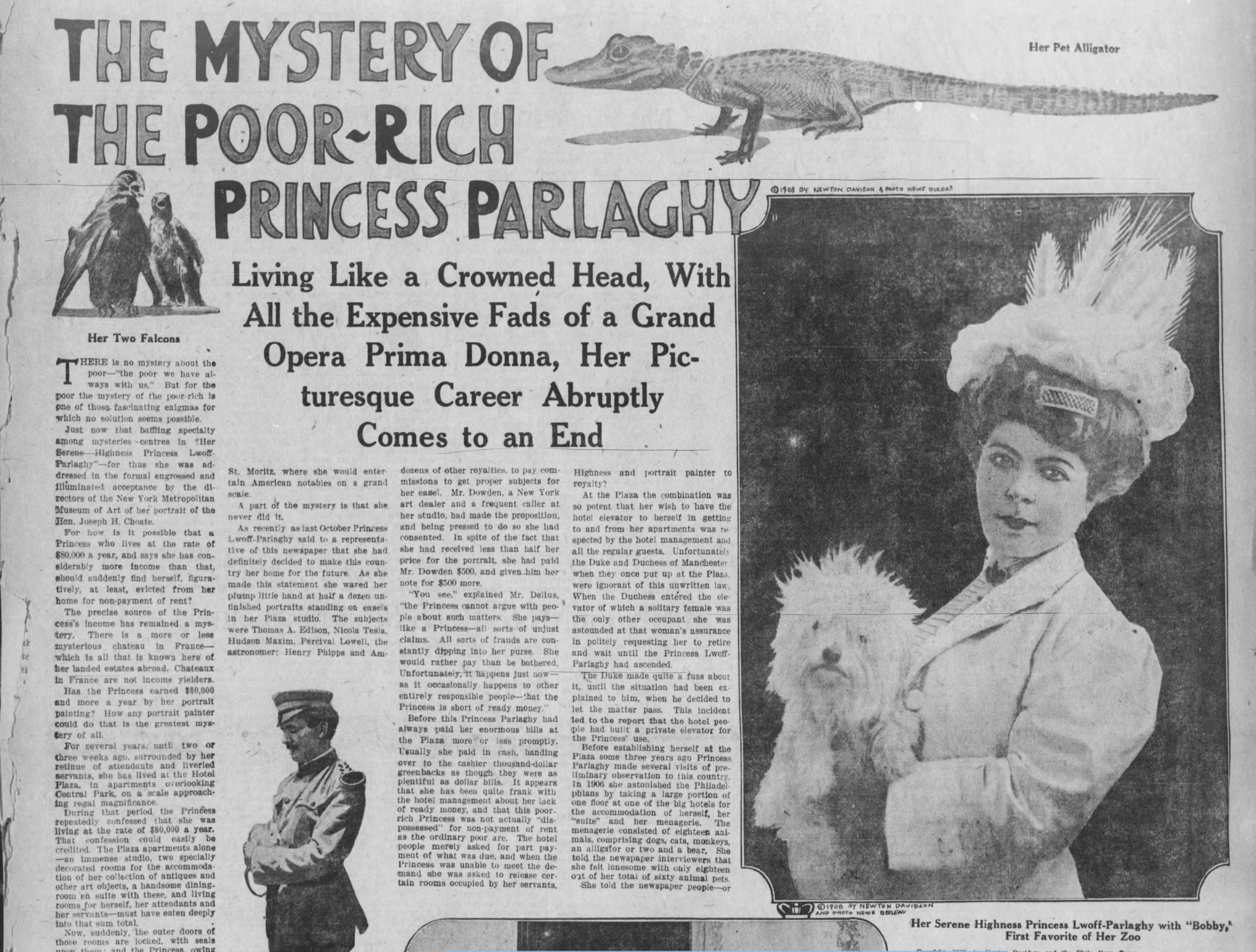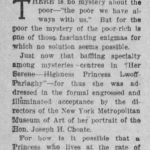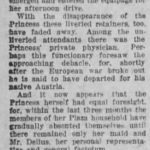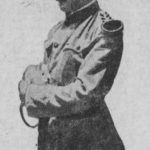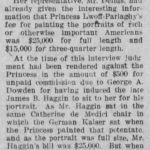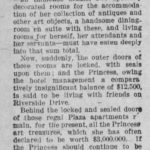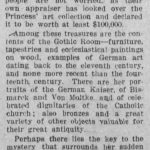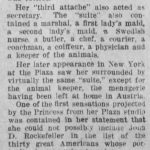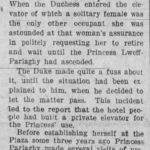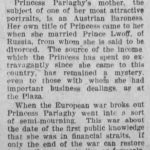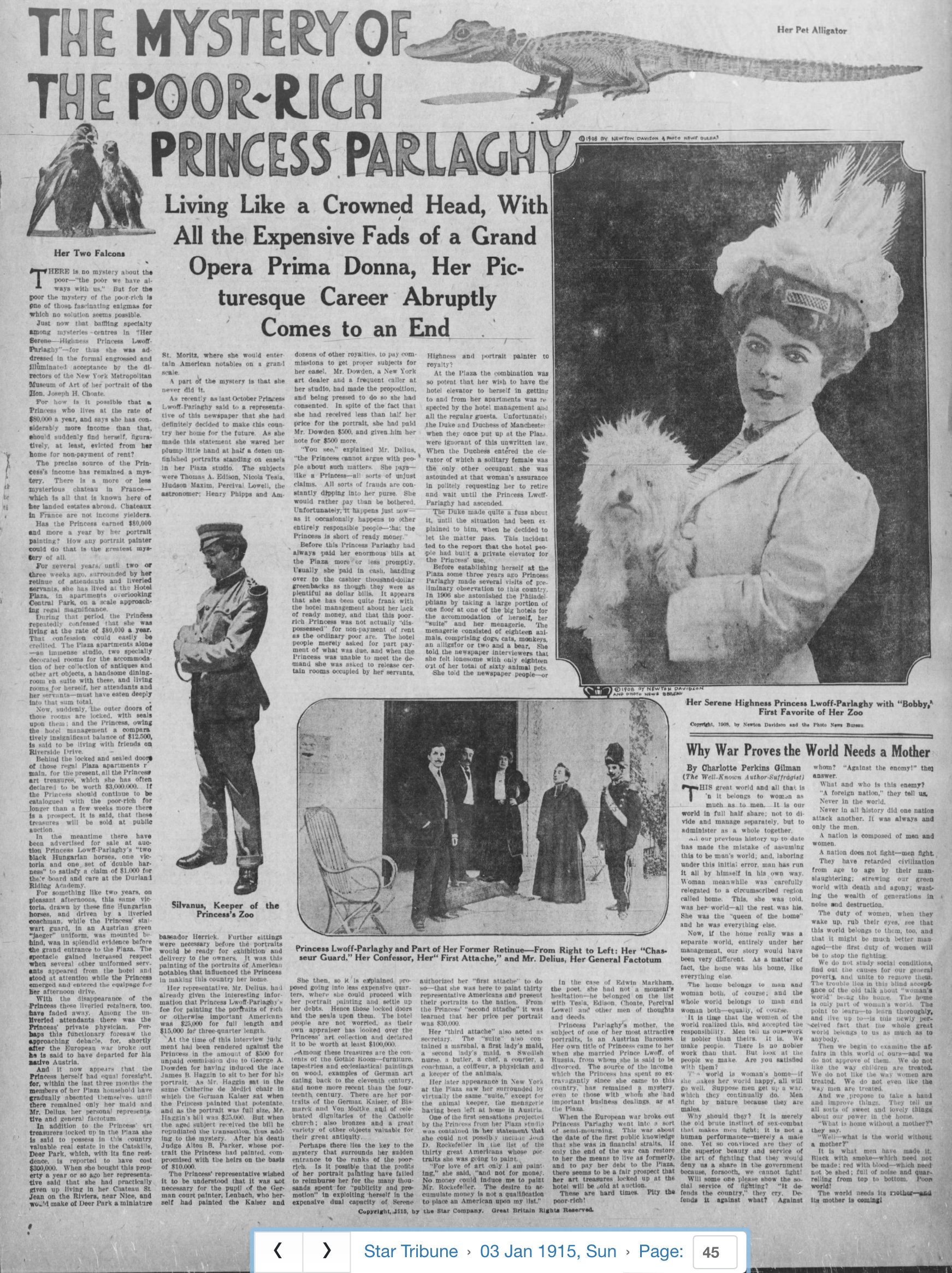The mystery of the wealthy and the poor has fascinated people for ages, but there is something particularly enigmatic about the case of Her Serene Highness Princess Lwoff-Parlaghy. Despite living at the rate of $80,000 per year, with considerably more income than that, the princess has been figuratively evicted from her home for non-payment of rent. The source of her income is unknown, and although she is said to own a chateau in France and valuable real estate in the Catskills, it remains a mystery how she could afford to live in the regal splendor of the Plaza hotel, with its extensive accommodations and attendant servants. Her art collection, which she has claimed is worth $3,000,000, remains locked away in her former apartment, alongside half-finished portraits of notable Americans, such as Thomas A. Edison and Henry Phipps.
Despite the apparent wealth, Princess Lwoff-Parlaghy has fallen on hard times, with the doors to her former home locked and sealed due to a comparatively insignificant balance of $12,500 owed to the hotel. Her liveried attendants and personal physician have disappeared, along with the Princess herself, who is said to be staying with friends on Riverside Drive. The fate of her art collection and real estate remains uncertain, with rumors of a public auction swirling around the locked doors of the Plaza apartment. Despite all this, the princess had claimed as recently as last October that she would make America her permanent home, and her unfinished portraits of prominent Americans stand as a testament to the life she once led.
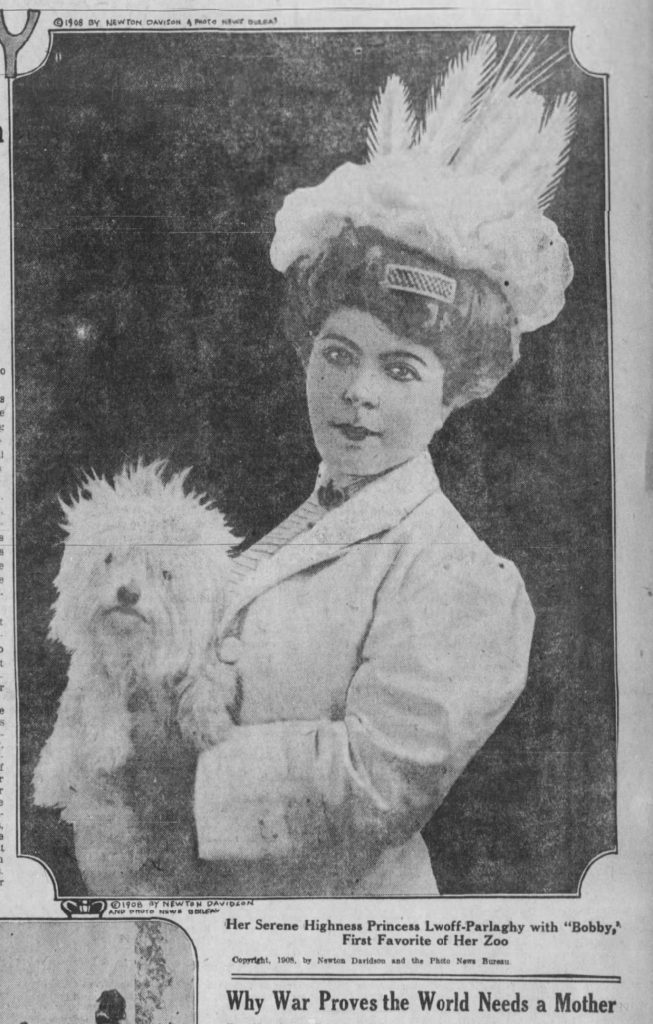
Full Article from The Star Tribune
There is no mystery about the poor “the poor we have always with us.” But for the poor the mystery of the poor-rich is one of those fascinating enigmas for which no solution seems possible.
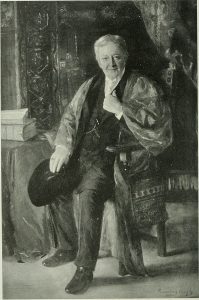
Just now that baffling specialty among mysteries centers in “Her Serene Highness Princess Lwoff-Parlaghy” for thus she was addressed in the formal engrossed and illúminated acceptance by the directors of the New York Metropolitan Museum of Art of her portrait of the Hon, Joseph H. Choate.
For how is it possible that a Princess who lives at the rate of $80,000 a year, and says she has considerably more income than that, should suddenly find herself, figuratively, at least, evicted from her home for non-payment of rent?
The precise source of the Princess’s income has remained a mystery. There is a more or less mysterious chateau in France which is all that is known here of her landed estates abroad. Chateaux in France are not income yielders. Has the Princess earned $80,000 and more a year from her portrait painting? How many portrait painters could do that is the greatest mystery of all.
For several years, until two or three weeks ago, surrounded by her retinue of attendants and liveried servants, she has lived at the Hotel Plaza, in apartments overlooking Central Park, on a scale approaching regal magnificence. During that period the Princess repeatedly confessed that she was living at the rate of $80,000 a year. That confession could easily be credited. The Plaza apartments alone an immense studio, two specialized decorated rooms for the accommodation of her collection of antiques and other art objects, a handsome dining room en suite with these, and living rooms for herself, her attendants and her servants must have eaten deeply into that sum total.
Now, suddenly, the outer doors of those rooms are locked, with seals upon them; and the Princess, owing the hotel management a comparatively insignificant balance of $12,500, is said to be living with friends on Riverside Drive.
Behind the locked and sealed doors of those regal Plaza apartments remain, for the present, all the Princess’s art treasures, which she has often declared to be worth $3,000,000. If the Princess should continue to be cataloged with the poor rich for longer than a few weeks there is a prospect. It is said, that these treasures will be sold at public auction.
In the meantime, there have been advertised sale at auction Princess Lowff-Parlaghy’s “two black Hungarian horses, one victoria and one set of ‘double harness” to satisfy a claim of $1,000 for their board and care at the Durland Riding Academy [external link icon].
For something like two years, on pleasant afternoons, this same victoria, drawn by these fine Hungarian horses, and driven by a liveried coachman, while the Princess’s stalwart guard, in an Austrian green “Jaeger” uniform, was mounted behind, was in splendid evidence before the grand entrance to the Plaza. The spectacle gained Increased respect when several other uniformed servants appeared from the hotel and stood at attention while the Princess emerged and entered the equipage for her afternoon drive.
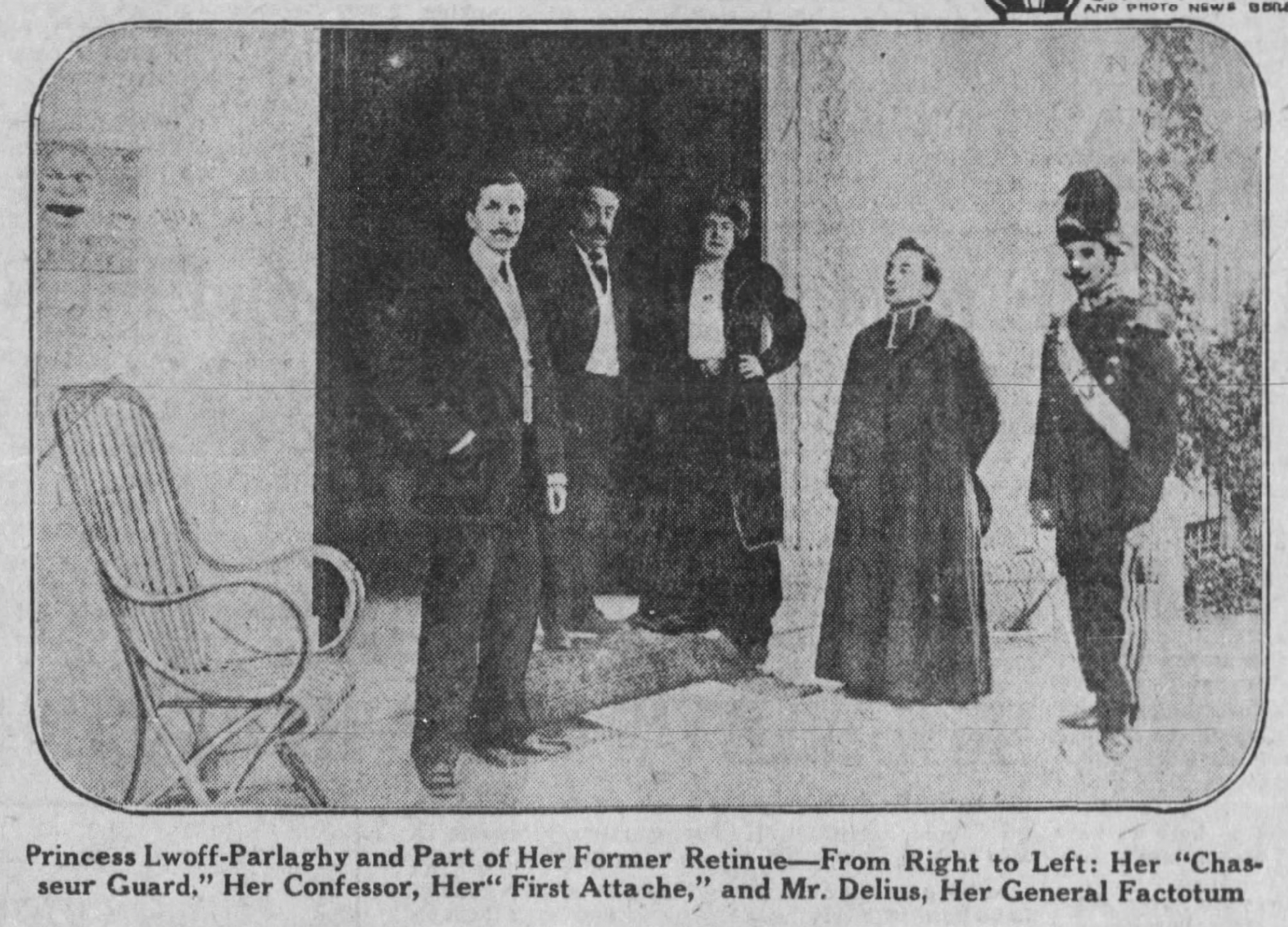
With the disappearance of the Princess these liveried retainers, too have faded away. Among the un-liveried attendants, there was the Princess’ private physician.
Perhaps this functionary foresaw the approaching debacle, for, abruptly after the European war broke out as is said to have departed for his native Austria. And it now appears that the Princess herself had equal foresight for, within the last three months the members of her Plaza household have gradually absented themselves until there remained only her maid and Mr. Delius, her personal representative and general factotum.
In addition to the Princess’s art treasures locked up in the Plaza she in said to possess in this country valuable real estate. In the Catskill, Deer Park, which, with its fine residence, is reported to have cost $300,000. When she bought this property a year or so ago, her representative said that she had practically given up living in her Chateau St-Jean on the Rivera, near Nice [external link icon], and would make of Deer Park a miniature St. Moritz. where she would entertain American notables on a grand scale. A part of the mystery is that she never did it.
As recently as last October Princess Lwoff-Parlaghy said to a representative of this newspaper that she had definitely decided to make this country her home for the future. As she made this statement she waved her plump little hand at half a dozen unfinished portraits standing on easels in her Plaza studio. The subjects were Thomas A. Edison, Nicola Tesla, Hudson Maxim, Percival Lowell, the astronomer; Henry Phipps and Ambassador Herrick.
Further sittings were necessary before the portraits would be ready for exhibition and delivery to the owners, It was this painting of the portraits of American notables that influenced the Princess in making this country her home. Her representative, Mr. Delius had already given the interesting information that Princess Lwoff-Parlaghy’s fee for painting the portraits of rich or otherwise important Americans was $25,000 for full length and $15,000 for three-quarter length.
At the time of this interview, judgement had been rendered against the Princess in the amount of $500 for unpaid commission due to George A. Dowden for having induced the late James B. Haggin to sit to her for his portrait. As Mr. Haggin sat in the same Catherine de Medici chair in which the German Kaiser sat when the Princess painted that potentate and the portrait was full size. Mr. Haggin’s bill was $25.000. But when the aged subject received the bill he repudiated the transaction, thus adding to the mystery. After his death, Judge Alton B. Parker, whose portrait the Princess had painted, compromised with the heirs on the basis of $10.000.
The Princess’ representative wished it to be understood that it was not necessary for the pupil of the German court painter, Lenbach, who herself had painted the Kaiser and dozens of other royalties, to pay commissions to get proper subjects for her easel.
Mr. Dowden, a New York art dealer and a frequent caller at her studio, had made the proposition, and being pressed to do so she had consented. In spite of the fact that she had received less than half her price for the portrait, she had paid Mr. Dowden $500, and given him her note for $500 more.
“You see.” explained Mr. Delius, “the Princess cannot argue with people about such matters. She pays, like a Princess, all sorts of unjust claims. All sorts of frauds are constantly dipping into her purse. She would rather pay than be bothered. Unfortunately, it happens just now as it occasionally happens to other entirely responsible people that the Princess is short of ready money.”
Before this Princess Parlaghy had always paid her enormous bills at the Plaza more or less promptly. Usually, she paid in cash, handing over to the cashier thousand-dollar greenbacks as though they were as plentiful as dollar bills. It appears that she has been quite frank with the hotel management about her lack of ready money and that this poor rich Princess was not actually “dis-possessed” for non-payment of rent as the ordinary poor are. The hotel people merely asked for part payment of what was due, and when the Princess was unable to meet the demand she was asked to release certain rooms occupied by her servants.
She then, so it is explained proposed going into less expensive quarters, where she could proceed with her portrait painting and settle up her debts.
Hence those locked doors and the seals upon them. The hotel people are not worried, as their own appraiser has looked over the Princess’ art collection and declared it to be worth at least $100,000.
Among these treasures are the contents of the Gothic Room furniture, tapestries, and ecclesiastical paintings on wood, examples of German art dating back to the eleventh century, and none more recent than the fourteenth century. There are her portraits of the German Kaiser, of Bismarck and Von Moltke, and of celebrated dignitaries of the Catholic church;
also bronzes and a great variety of other objects valued for their great antiquities.
Perhaps there lies the key to the mystery that surrounds her sudden entrance to the ranks of the poor rich. Is it possible that the profits of her portrait painting have failed to reimburse her for the many thousands spent for “publicity and promotion” in exploiting herself in the expensive dual capacity of Serene Highness and portrait painter to royalty?
At the Plaza, the combination was so potent that her wish to have the hotel elevator to herself in getting to and from her apartments was respected by the hotel management and all the regular guests. Unfortunately, the Duke and Duchess of Manchester when once put up at the Plaza. were ignorant of this unwritten law When the Duchess entered the elevator of which a solitary female was the only other occupant she was astounded at that woman’s assurance in politely requesting her to retire and wait until the Princess Lwoff-Parlaghy had ascended. The Duke made quite a fuss about it until the situation had been explained to him when he decided to let the matter pass.
This incident led to the report that the hotel people had built a private elevator for the Princess’s use. Before establishing herself at the Plaza some three years ago Princess Parlaghy made several visits to the preliminary observation of this country.
In 1906 she astonished the Philadelphians by taking a large portion of one floor at one of the big hotels for the accommodation of herself, her “suite” and her menagerie. The menagerie consisted of eighteen animals, comprising dogs, cats, monkeys, an alligator or two and a bear. She told the newspaper interviewers that she felt lonesome with only eighteen out of her total of sixty animal pets.
She told the newspaper people or authorized her “first attache” to do so that she was here to paint thirty representative Americans and present their portraits to the nation. From
the Princess’s “second attache,” it was learned that her price per portrait was $30,000. Her “third attache” also acted as secretary. The “suite” also contained a marshal, a first lady’s maid, a second lady’s maid, a Swedish nurse, a butler, a chef, a courier, a coachman, a coiffeur, a physician, and a keeper of the animals.
Her later appearance in New York at the Plaza saw her surrounded by virtually the same “suite,” except for the animal keeper, the menagerie having been left at home in Austria, One of the first sensations projected by the Princess from her Plaza studio was contained in her statement that she could not possibly include John D. Rockefeller in the list of the thirty great Americans whose portraits she was going to paint. For the love of art only I am painting.” she said, “and not for money. No money could induce me to paint Mr. Rockefeller. The desire to accumulate money is not a qualification to place an American upon my list.”
 In the case of Edwin Markham, the poet, she had not a moment’s hesitation, he belonged on the list with Tesla, Edison, Choate, Percival Lowell, and other men of thoughts and deeds.
In the case of Edwin Markham, the poet, she had not a moment’s hesitation, he belonged on the list with Tesla, Edison, Choate, Percival Lowell, and other men of thoughts and deeds.
Princess Parlaghy’s mother, the subject of one of her most attractive portraits, is an Austrian Baroness. Her own title of Princess came to her when she married Prince Lwoff, of Russia, from whom she is said to be divorced. The source of the income which the Princess has spent so extravagantly since she came to this country, has remained a mystery, even to those with whom she had important business dealings, as at the Plaza. When the European war broke out Princess Parlaghy went into a sort of semi-mourning. This was about the date of the first public knowledge that she was in financial straits.
If only the end of the war can restore to her the means to live as formerly, and to pay her debt to the Plaza, there seems to be a fair prospect that her art treasures locked up at the hotel will be sold at auction. These are hard times. Pity the poor rich!
